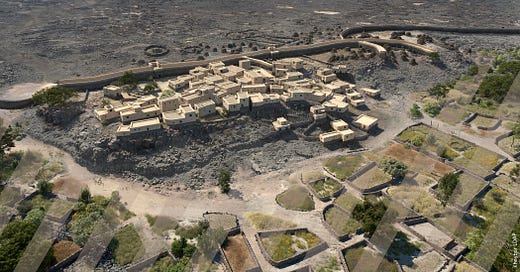Uncovering Arabia's Slow Urban Evolution in the Bronze Age
Recent excavations in northern Arabia reveal a gradual shift toward urbanization, showcasing small fortified towns from the Early Bronze Age.
Tracing Urban Beginnings
Urbanization, a hallmark of ancient civilizations, is often linked to complex societies in regions such as Mesopotamia and the Levant. However, findings in northern Arabia indicate that urban development here took on a slower, more gradual trajectory during the Bronze Age. New research, led by Guillaume Charloux and published in PLOS ONE1, focuses on the third-to-second-millennium BCE town of al-Natah, shedding light on Arabia's unique urbanization process during this era.

A Closer Look at al-Natah: A Small Bronze Age Town
Al-Natah, located in the Medinah province, was a settlement that spanned roughly 1.5 hectares, with archaeologists dating its occupation from approximately 2400 to 1500 BCE. The town was strategically organized with a central district, nearby residential areas, and fortified walls that protected its modest population. Unlike the larger, more complex urban sites of neighboring civilizations, al-Natah likely held around 500 residents, and evidence suggests a somewhat stratified society indicated by burial practices in its necropolis.
Despite its relative simplicity, al-Natah is comparable in size and structure to other small fortified towns in northern Arabia. The similarities among these sites reveal that Arabia had settlements during the Early and Middle Bronze Ages but lacked the socio-political complexity seen in contemporary regions.
"Low Urbanization" in Northern Arabia: A Transition in Progress
The term "low urbanization" aptly describes the developmental stage of settlements like al-Natah. This intermediate phase, positioned between nomadic pastoral lifestyles and full-fledged urban centers, suggests that Arabia was moving slowly toward more organized settlements. Fortified towns in Arabia were markedly smaller and less complex than those in Mesopotamia or the Levant, hinting at the distinctive evolutionary path of Arabian urbanism.
While other Bronze Age cultures had advanced in terms of population density, specialized labor, and structured hierarchies, northern Arabian towns remained modest, indicating a more gradual cultural and social shift. This raises questions about the conditions—both environmental and social—that shaped Arabian settlement patterns.
Archaeology and the Role of Social Complexity in Early Arabian Towns
The modest urban organization found at al-Natah and similar sites suggests that early Arabian communities functioned as social and trade centers without the hierarchical systems common in more complex urban societies. The fortified nature of al-Natah and the presence of defensive structures likely stemmed from the need for security and controlled access, reflecting a certain level of social organization.
Necropolis burial sites found near al-Natah show evidence of social stratification, perhaps denoting an emerging sense of community structure and wealth accumulation. However, no indications of elaborate governance or extensive trade networks typical of Mesopotamian city-states have been found, indicating that these communities were still rooted in pastoralism while transitioning to sedentary life.
Expanding Understanding through Further Excavations
Northern Arabian sites like al-Natah offer an unprecedented view into early urbanization in Arabia, illuminating the social and environmental factors that influenced these early settlements. As Charloux notes, the discovery of a fortified Bronze Age town connected by a rampart network underscores Arabia’s potential role in regional urban development. Future archaeological work may reveal more about the timing and extent of urbanization in this region and its unique trajectory.
Conclusion: A Unique Path Toward Civilization
The al-Natah settlement and other fortified Bronze Age towns in northern Arabia showcase an evolution toward urbanization marked by slower development and limited social complexity. Rather than following a linear path to structured, hierarchical societies, northern Arabia’s towns reflect an adaptation to their environment and available resources. This study underscores the diversity in ancient urban evolution and the importance of considering regional adaptations when studying the origins of civilization.
Further excavation across Arabian sites will undoubtedly yield more insights, shaping a nuanced understanding of urbanization beyond the boundaries of Mesopotamia and the Levant. As archaeologists continue to unearth evidence of these early settlements, the story of Arabian urbanization stands poised to expand our comprehension of early human civilization in the ancient world.
Charloux, G., Shabo, S., Depreux, B., Colin, S., Guadagnini, K., Guermont, F., Dupuy, S., Bussy, M., Bec Drelon, N., Poulmarc’h, M., Albukaai, D., Alshilali, S., Crassard, R., & AlMushawh, M. (2024). A Bronze Age town in the Khaybar walled oasis: Debating early urbanization in Northwestern Arabia. PloS One, 19(10), e0309963. https://doi.org/10.1371/journal.pone.0309963


